Key takeaways:
- Educational rehabilitation initiatives empower individuals by providing skills and fostering community, helping to rebuild identities and restore hope.
- Advocacy against the death penalty highlights the need for a justice system that values rehabilitation and addresses social injustices, emphasizing the risk of wrongful convictions.
- Challenges in educational efforts include stigma, resource limitations, and lack of collaboration between educational institutions and rehabilitation programs, hindering effective support.
- The positive impact of these initiatives extends to communities, resulting in reduced crime rates, improved morale, and a ripple effect of mentorship and inspiration among residents.
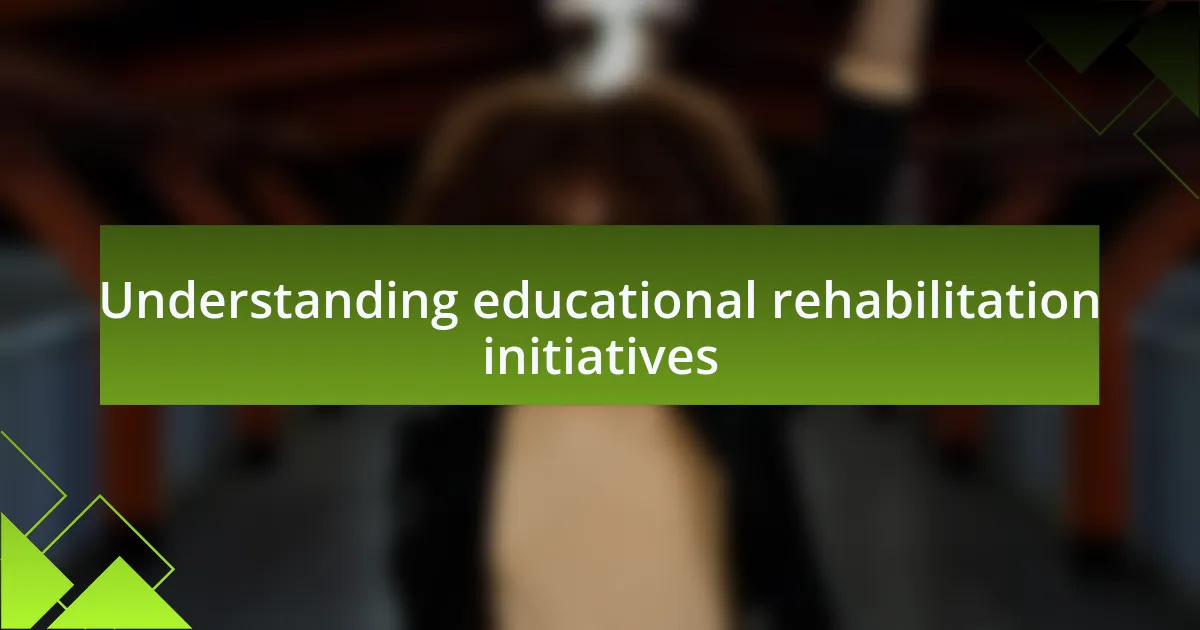
Understanding educational rehabilitation initiatives
Educational rehabilitation initiatives focus on transforming lives through learning, especially for individuals who have faced significant challenges, such as incarceration. In my experience, these programs don’t just teach skills; they ignite hope. How powerful is it to see someone who once felt hopeless begin to envision a future?
I’ve often witnessed the profound impact that education can have on personal narrative. For instance, one participant I met in a rehabilitation program shared how learning to read and write opened up new avenues for understanding the world around him. Isn’t it impressive to realize that something as fundamental as literacy can empower someone to break free from cycles of despair?
Moreover, educational initiatives foster a sense of community among participants. I remember attending a class where individuals shared their stories and support for one another. It struck me how, through education, these individuals were not just gaining knowledge but also rebuilding their identities and connecting with others on a deeper level. What does that sense of belonging mean for someone who has felt isolated for so long?
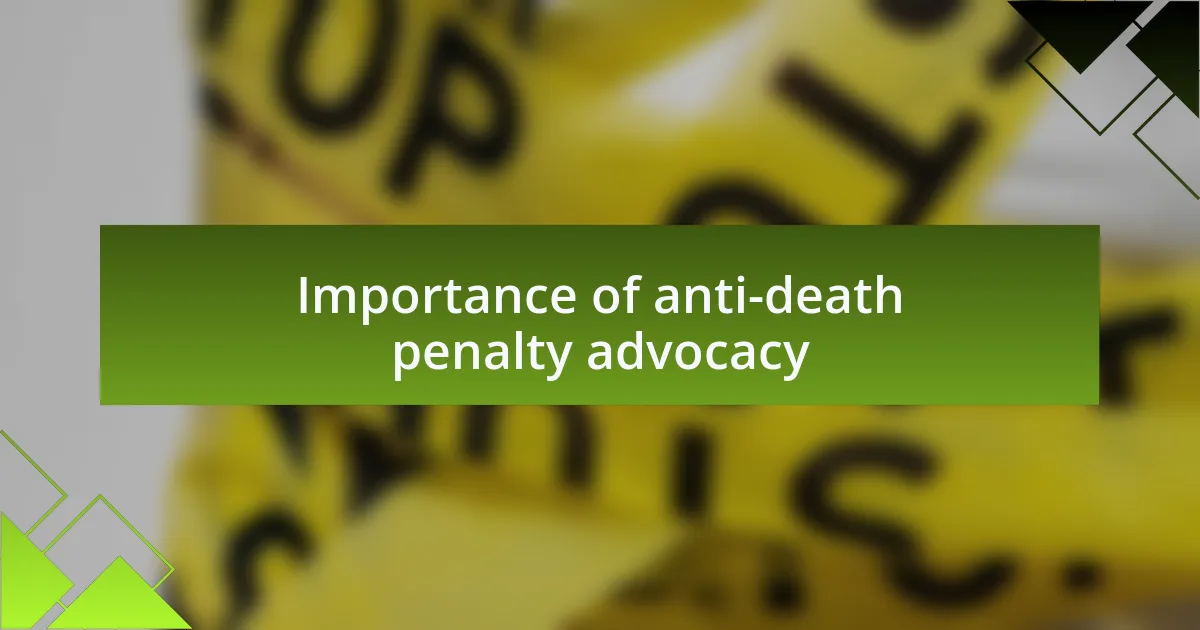
Importance of anti-death penalty advocacy
The importance of anti-death penalty advocacy cannot be overstated. Personally, I’ve come to understand that every life is valuable and redeemable. Engaging in this work has taught me that advocating against the death penalty is not just about saving lives; it’s about promoting a justice system that prioritizes rehabilitation over retribution. When I speak to others about this, I often wonder, how can we justify a system that punishes with such finality?
Moreover, advocating against the death penalty also addresses deep-rooted social injustices. I recall a discussion I had with a group of activists who shared their experiences with wrongful convictions. Hearing their stories reinforced my belief that the risk of executing an innocent person is a tragic flaw in our justice system. Can we really stand by a practice that has the potential to snuff out a life based on mistakes and biases?
Finally, being part of the anti-death penalty movement has shown me the importance of fostering empathy in our society. I remember a poignant moment during a community event where families of victims and those on death row shared their stories. It was heart-wrenching yet enlightening to witness how advocacy can bridge divides. What if more people understood these complex narratives—would they be more inclined to support a more humane approach to justice?
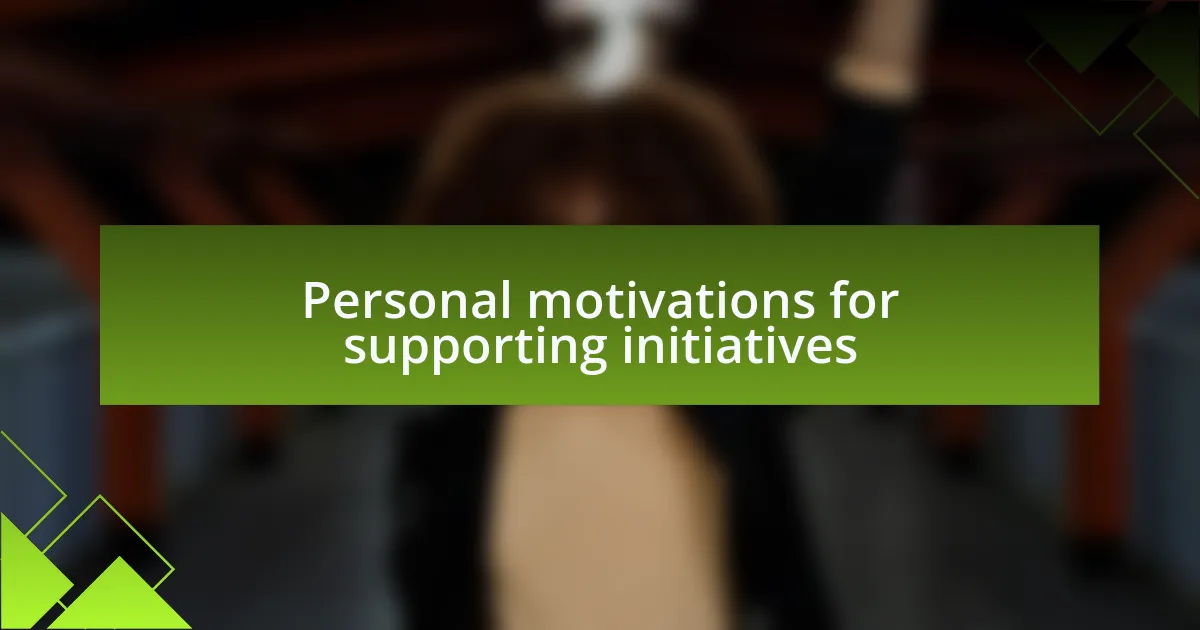
Personal motivations for supporting initiatives
When I reflect on my motivations for supporting educational rehabilitation initiatives, a strong sense of empathy comes to mind. I remember volunteering at a local outreach program where I met individuals who had committed crimes yet were eager to change their paths. Hearing their aspirations to pursue education rather than remain trapped in a cycle of despair truly resonated with me. How can we deny them the chance to redeem themselves through learning and growth?
Additionally, I’ve witnessed firsthand the transformative power of education in shaping lives. During a workshop I attended, a former inmate shared how accessing educational resources empowered him to rebuild his life and reconnect with his family. It made me realize that providing education is not just about filling minds with knowledge; it’s about igniting hope and motivating individuals to strive for a better future. Isn’t it our responsibility to support such life-changing initiatives?
Ultimately, my personal experiences have compelled me to advocate for these initiatives. I’ve seen people blossom when given the right tools and opportunities. The question lingers: if we believe in the potential for change, why wouldn’t we fight for those who are willing to take that first step towards rehabilitation?
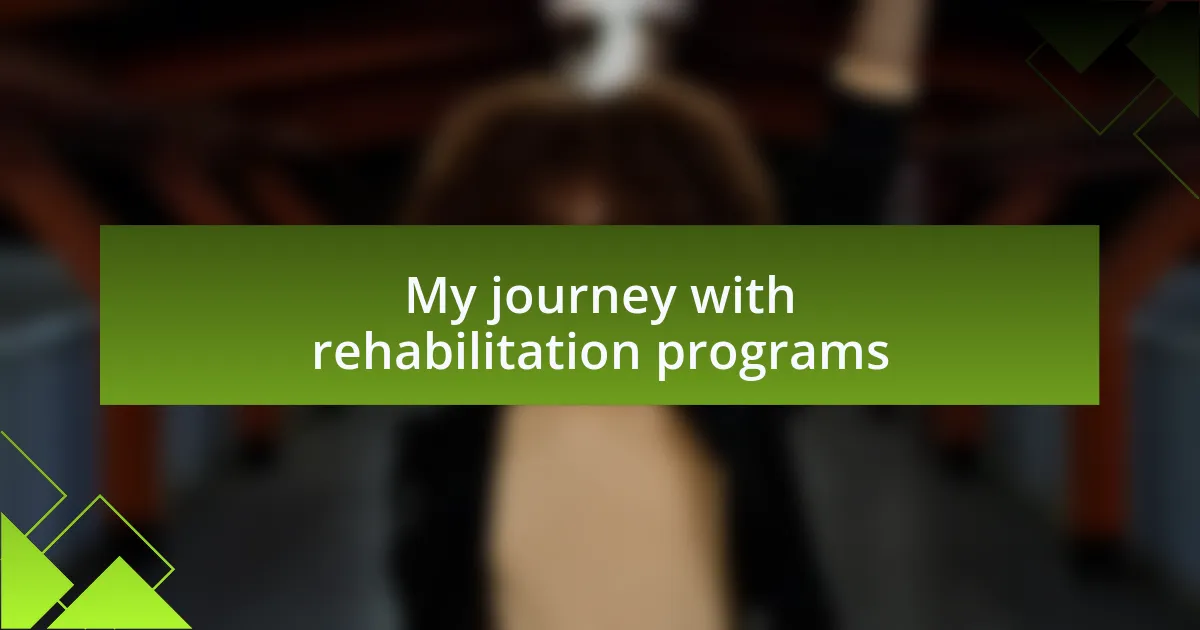
My journey with rehabilitation programs
My journey with rehabilitation programs has been nothing short of eye-opening. I recall a weekend spent at a community center where I facilitated a literacy class for individuals trying to reintegrate into society. Their determination to learn, despite the obstacles they faced, left an indelible mark on me. How is it possible that in such challenging circumstances, they still possess the will to forge a better future?
I also remember a particularly poignant moment with one participant who shared that learning to read and write opened a new world for him. It wasn’t just about the skills; it was about restoring a sense of dignity and purpose. This experience underscored for me that education can be a lifeline, not merely a path to knowledge, but a way to heal the wounds of the past. Isn’t it incredible how the act of learning can empower individuals to reclaim their stories?
Lastly, I’ve actively participated in mentoring programs where I engaged one-on-one with individuals eager to change their lives. I witnessed how the right support could spark something profound within them. Their stories often left me pondering: if we invest in people during their lowest points, what heights could they achieve? The potential is boundless, and I firmly believe that everyone deserves a chance to rise above their circumstances.
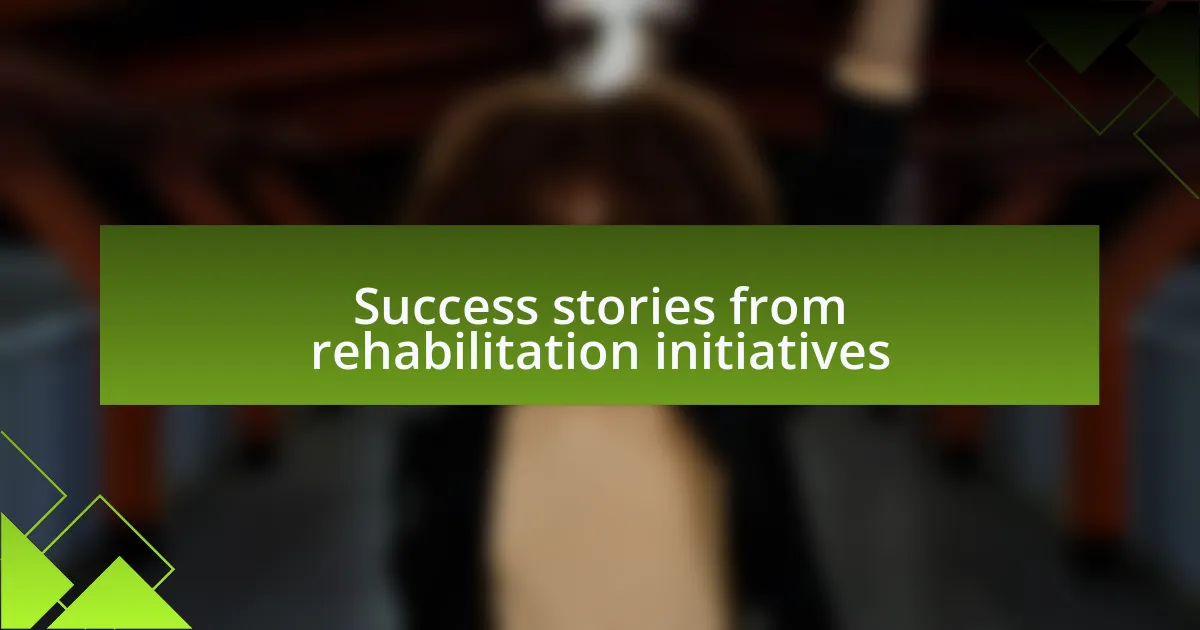
Success stories from rehabilitation initiatives
While working alongside a rehabilitation initiative, I encountered a young woman who had once faced overwhelming societal backlash. She had managed to turn her life around through a vocational training program focused on culinary skills. I was amazed not only by her newfound talent but also by the joy radiating from her as she prepared her first meal for public service. Wasn’t it inspiring to see how a simple opportunity can transform despair into hope?
Another memorable moment came during a community project where participants worked together to renovate a local park. The pride in their faces as they created a space for families to enjoy was palpable. When one man, who had struggled for years, spoke about wanting to give his children a safe place to play, it reminded me of the profound impact rehabilitation can have—not just on individuals, but on entire families and communities. Can we truly measure the power of such experiences?
I’ve also seen how storytelling workshops have been crucial for many involved in rehabilitation. One individual recounted his journey through art and words, expressing emotions he had bottled up for years. Watching others nod in understanding and empathy was remarkable. How often do we underestimate the healing power of sharing our stories? It reinforced my belief that rehabilitation is about forging connections and fostering a sense of belonging.
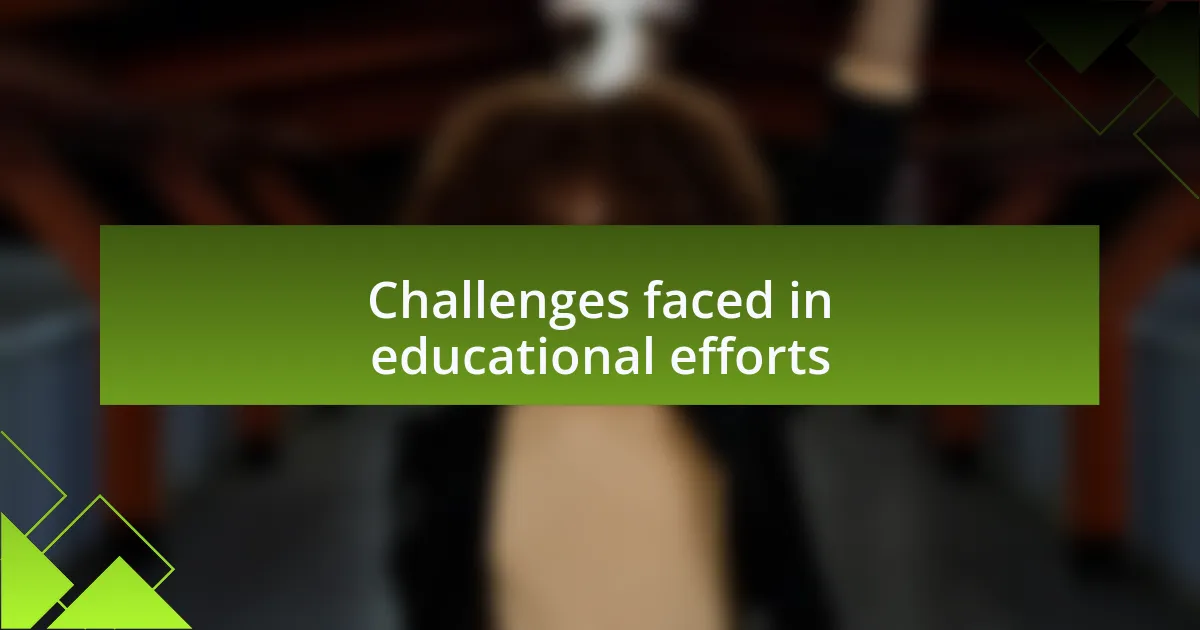
Challenges faced in educational efforts
One significant challenge I’ve observed in educational efforts is the prevailing stigma that often surrounds individuals involved with the justice system. I remember facilitating a workshop where a participant shared her frustration about securing employment after completing her training. The reluctance of employers to consider someone with a criminal history can create a vicious cycle that undermines the very purpose of rehabilitation. How can we expect transformation if society continues to view these individuals through a lens of prejudice?
Another hurdle lies in the availability of resources. I once volunteered for a campaign aimed at providing educational materials and tools, only to discover that funding was consistently a challenge. It was disheartening to witness eager participants eager to learn but unable to access the training they needed due to budget constraints. Isn’t it ironic that the very initiatives meant to uplift and educate often struggle to find support?
Lastly, the lack of collaboration between educational institutions and rehabilitation programs frequently hampers progress. I attended a meeting where the disconnect between local schools and rehabilitation services became painfully clear. What good is a program if the potential pathways for continued education aren’t aligned? It left me pondering how we can create seamless transitions for individuals who are striving to build a new life.
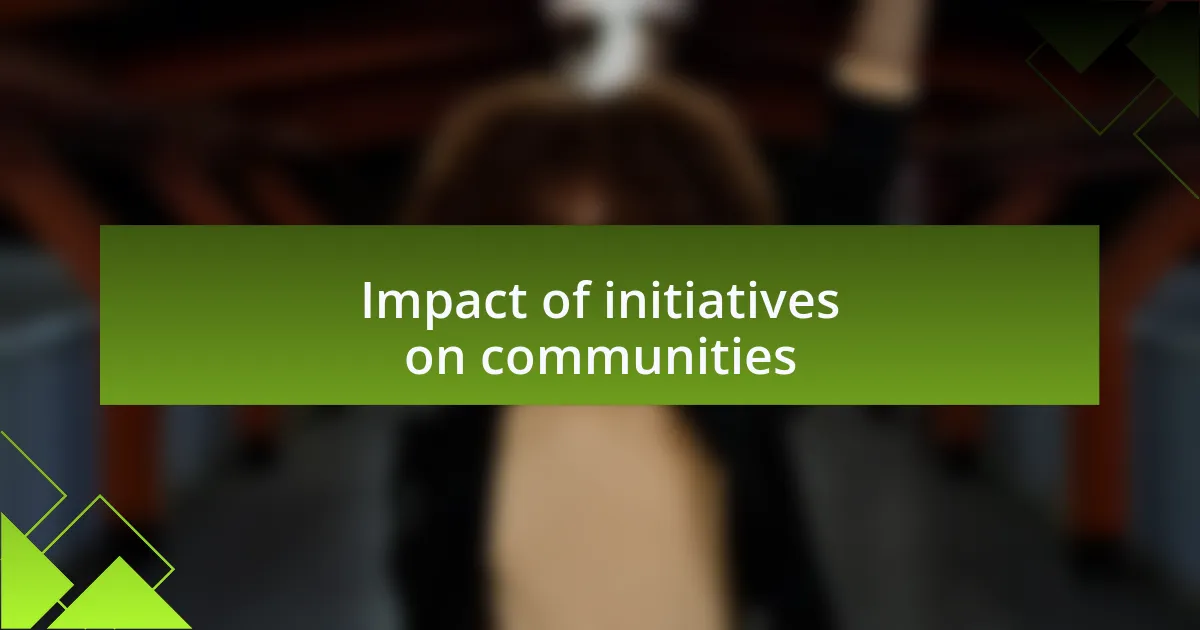
Impact of initiatives on communities
The impact of educational rehabilitation initiatives on communities can be transformative. I remember visiting a neighborhood where a local program had been implemented. Residents spoke about how the education provided not only equipped individuals with necessary skills but also ignited hope within the community. When individuals thrive, the entire community benefits—from reduced crime rates to improved morale. Isn’t it remarkable how knowledge can uplift an entire neighborhood?
Moreover, these initiatives foster a sense of belonging. I once witnessed a group of former participants come together to support each other, sharing job leads and life experiences. This newfound camaraderie created bonds that extended beyond the classroom, strengthening community ties. What happens when individuals feel connected? They not only succeed individually but also uplift each other, creating a supportive network where everyone can flourish.
Finally, educational initiatives often inspire a ripple effect. I recall a resident who completed a vocational program and subsequently became a mentor for others. This individual’s journey inspired those around them to pursue their own goals. It made me wonder—how many lives can be changed by one person’s success? The answer is profound. When communities invest in rehabilitation through education, they set the stage for a cycle of positive change.